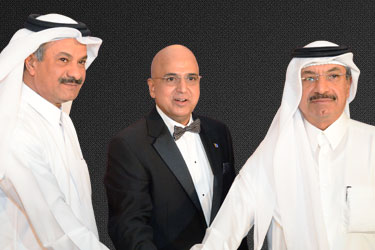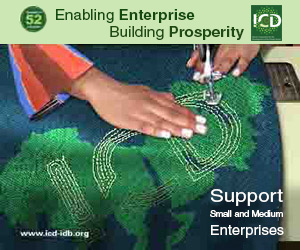As one of Qatar's leading financial services institution, Doha Bank has been consistently registering strong growth during the last decade in terms of asset growth, loan growth, deposit growth and increase in shareholders’ value.
Doha Bank established its overseas branches in Kuwait, Dubai (UAE) and Abu Dhabi (UAE) as well as Representative offices in Japan, China, Singapore, Hong Kong, South Korea, Australia, South Africa, Turkey, the United Kingdom, Canada, Germany and Sharjah (UAE). Recently, Doha Bank completed the process of amalgamation of the HSBC Bank Oman’s India operations as at the close of business on March 31, 2015. Doha Bank held the inauguration ceremony of its Indian operations on Wednesday, 29 April 2015 in Mumbai. Doha Bank is the first Qatari Bank to establish its full scale banking operations in India. In order to find out more about this recent expansion, BUSINESS LIFE held an exclusive interview with Dr. R. Seetharaman, CEO of Doha Bank.
BL: What is the significance of this new venture into the Indian market and what services are you planning on delivering?
Dr. Seetharaman: The huge size of the Indian market, along with its rising per capita income levels and business-friendly policies, render India as an essential and strategic location for Doha Bank. We are keen to expand our operational presence in India in the years to come and have already set in motion our plans to service the customers through innovative and technology driven products and services. Some of the key products and services include comprehensive NRI 4 in 1 account packages, privileged status for HNIs, credit passportability, Project Finance/advisory services to link GCC markets, ECBs, unique deposit/investment products for Non Resident Indians. All these products would be appropriately supplemented by technology driven solutions such as digital account opening - Tablet Banking, best in class mobile as well as phone banking solutions with SMS Alerts, robust Internet Banking solutions, instantaneous e-remittances from GCC to India, online payment integration with utility services and dedicated ‘India Desk’ across all Doha Bank overseas locations to service its customers. The bank will play a significant role in bridging the GCC investors with various business houses seeking investments in India, in line with the vision set out by the Government of India and thus fulfill the needs of the investors and the entrepreneurs through its dedicated Project Finance team.
BL: Who attended the opening ceremony?
Dr. Seetharaman: The inauguration ceremony was well attended by several high-profile dignitaries including H.E. Ali Sharif Al Emadi, Qatar’s Minister of Finance, H.E. Sheikh Abdullah Bin Saoud Al-Thani, the Governor of Qatar Central Bank and Shri Suresh Prabhu, India’s Minister of Railways. The inauguration ceremony was also attended by the Indian Ambassador to the State of Qatar Sanjiv Arora, Ambassador of the State of Qatar to India, Ahmed Ibrahim al Abdullah, Ambassador to India from other Gulf Cooperation Council (GCC) countries, Minister of Industries – Government of Maharashtra, Subhash Desai, Minister of State for Finance and Rural Development, Government of Maharashtra, Deepak Vasantrao Kesarkar, Consular Generals from the GCC countries, and leaders from key corporates, prominent dignitaries from GCC countries as well as India along with senior members from the banking community in India.
Doha Bank was represented by H.E. Sheikh Fahad Bin Mohammad Bin Jabor Al Thani, Chairman, H.E. Sheikh Abdul Rehman Bin Mohammad Bin Jabor Al Thani, Managing Director, Ahmed Al Khal, Board Member of Doha Bank, and myself along with our senior management team.
BL: So what are your plans for your Indian operations?
Dr. Seetharaman: Doha Bank has been pursuing a well thought-out international expansion strategy by extending our global footprint across 15 nations worldwide. In this pursuit, Doha Bank is the first Qatari Bank to establish its full scale banking operations in India. Doha Bank will adopt a GCC-banking model tailored to domestic needs. It will focus on bilateral trade, investment and banking relationships between the two blocks and also leverage on economic linkages.
Doha Bank aims to capitalise on the large number of Indian expatriates and Indian companies in Qatar as well as the wider GCC region. Doha Bank will focus on Indian corporates targeting the GCC. Doha Bank will also focus on the remittances segment and on retail products and wealth management products to NRI customers in India. We will leverage our GCC network and support our clients at both the ends. With a special focus on small and medium enterprises, Doha Bank’s India operations will provide comprehensive range of financial services by deploying consumer-centric technology and innovative delivery channels.
BL: Why is India such a promising market?
Dr. Seetharaman: Our expansion in the Indian subcontinent is historic. We consider India as an important market, being one of the fastest growing economies in the world, which is expected to overtake China in the years to come. The IMF April 2015 outlook expects growth in India at 7.2 percent in 2014-15, and at 7.5 percent in 2015-16 respectively. India’s consumer price inflation (CPI) rate was at 5.17 percent in March 2015. The Indian budget for 2015 expects consumer inflation to remain close to 5 per cent by March 2015 and thereby, opening room for more monetary policy easing. The monetary policy framework agreement with the RBI clearly states objective of keeping inflation below 6 per cent. The current account deficit for FY 2015 is expected to be 1.3 per cent of GDP and fall below 1 per cent in the next fiscal on the back of easing of global commodity prices including petroleum products. The fiscal deficit target of 2014-15 is 4.1 percent of GDP. The Fiscal deficit is expected at 3.9 per cent of GDP in 2015- 16 and 3.6 percent of GDP in 2016-17. So all the economic indicators are there.
BL: What about GCC-India bilateral relations?
Dr. Seetharaman: Doha Bank plays a niche role in facilitating trade between the GCC and India and the inauguration of banking operations in India is a step towards further cementing that role. Let me give you some key indicators of GCC-India bilateral relations. Imports of the GCC from India have decreased by 6% in 2013-14 (when compared to PY) to $48bn. Exports of GCC to India have decreased by 5.5% in 2013-14 (when compared to PY) to $102bn. Overall trade to India has decreased by 6% in 2013-14 (when compared to PY) over $150bn. However, the exports to India have dropped mainly from the UAE, which was offset by a surge in other countries. Likewise, imports from India have also dropped mainly from the UAE and again, this was offset by a surge in other countries.
BL: What sort of figures are we talking about?
Dr. Seetharaman: The bilateral trade between India and the UAE during 2013-14 is above US$59 billion. India’s investment in the UAE could be around US$52 billion, excluding companies based in free zones in Dubai, Abu Dhabi and other emirates. Moreover, the UAE ranks 10th among the top investing countries in India. UAE’s investments in India are concentrated mainly sectors such as power, metallurgical industries construction development, services sector, computer software and hardware. India and the UAE are working towards a Bilateral Investment Promotion and Protection Agreement to enhance investments. The agreement is aimed at driving investments into India from the UAE across different sectors, including construction, downstream manufacturing in the petroleum and natural gas sector, as well as agriculture and food processing. In March 2014, a consortium led by Abu Dhabi National Energy Co had agreed to buy two Indian hydroelectric power plants from Jaiprakash Power Ventures in a deal worth about $1.6 billion.
BL: How about the India-Kuwait bilateral relations?
Dr. Seetharaman: The bilateral trade between Kuwait and India during 2013-14 is above USD 18 billion mainly on account of a surge in exports to India. The surge in exports is mainly from mineral fuels. India has consistently been among the top 10 trading partners of Kuwait. Kuwaiti investments in India are in excess of $ 2.5 billion. Kuwait wants Indian companies to bid for gas, railways, construct hospitals and schools and other infrastructure projects. India is a major importer of crude from Kuwait. It imports about $16 billion of crude annually from Kuwait. In November 2013, India and Kuwait agreed to expand cooperation in key areas including energy and investment.
BL: Perhaps, most importantly, how are India-Qatar bilateral relations?
Dr. Seetharaman: Qatar’s major exports to India include Petrochemicals, LNG, fertilizers, Sulphur and Iron Pyrites. Qatar’s major imports from India include accessories, manmade yarn, fabrics, made-ups, cotton yarn, transport equipment, machinery and instruments, manufacture of metals, ores and minerals. The bilateral trade between Qatar and India during 2013-14 exceeded US$ 16 bn. There has been a marginal surge in imports from India to Qatar. RasGas entered into a 25-year 7.5 MTA sale and purchase agreement with Petronet and has been supplying the Indian market since 2004. In December 2013 RasGas delivered a liquefied natural gas cargo to India’s Petronet at its new LNG Terminal located in Kochi.
Qatar is the largest supplier of LNG to India. There is a large market for Qatar’s LNG, oil and petrochemical sectors in India. In May 2013 Qatar has bought a 5% stake in Indian telecoms firm Bharti Airtel Ltd for $1.26bn. Many Indian Companies such as L&T, Tata Projects, Voltas, and Punj Llyod have active relationships in the Qatari market through partnerships, agencies and even have set up their offices in the Qatar. In March 2015, the MOUs signed between Qatar and India include an MoU for Cooperation in the field of Information and Communication Technology; an MoU between the ministry of earth sciences and Qatar Meteorological Department for Scientific and Technical cooperation; an MoU between Diplomatic Institute of the Ministry of Foreign Affairs, Qatar and Foreign Service Institute of the ministry of external affairs; an MoU for cooperation in the field of Radio and Television; and an agreement for Mutual Cooperation and Exchange of News.
BL: What about remittances to India by the large amount of migrant workers in the GCC?
Dr. Seetharaman: The GCC remained the largest source of remittances to India in the last financial year, accounting for 35 per cent of the total remitted amount of $71 billion in 2013. India will retain its top spot with USD 71 billion in remittances in 2014 as remittances to developing countries are expected to reach USD 435 billion, an increase of five per cent over 2013. Apart from FDI & FII, Remittances are also an excellent source of investment to India. The substantial financial resources and long-term infrastructure development plans of the GCC countries imply that they will continue to demand migrant workers and contribute to remittances to India. However, remittance flows could decline if the oil price were to remain low for a few years. The strength of the dollar against the Indian rupee in recent years also contributed to increased remittance and any change in currency dynamics will impact remittance.
BL: How can Indian companies participate in Qatar economy?
Dr. Seetharaman: India is encouraging Foreign Direct Investment (FDI). FDI inflows to India were estimated to be US$35 billion in 2014. Foreign investors can put in as much as US$ 14.65 billion in India’s rail infrastructure through the FDI route. In Dec 2014, India has passed a new rule to approve 100% FDI in its medical devices sector, as India imports 70% of its required equipment in this sector.
In March 2015, a bill in the Insurance sector passed, which will now allow foreign direct investors to infuse up to 49% in the Indian insurance companies. India is now allowing 100 per cent FDI in the construction sector. FDI ceiling in the sensitive defense sector has been raised from the current 26 per cent, with the condition that the company seeking permission of the government for FDI up to 49 per cent as long as the company is owned and controlled by Indians.










